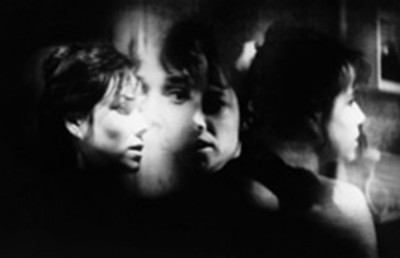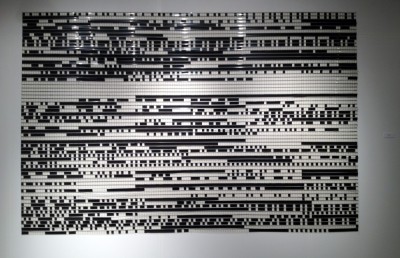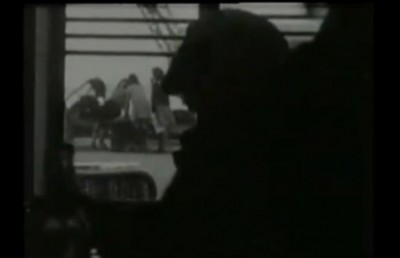Austrian Avant-Garde Cinema Explored, Part 2
Index DVDs
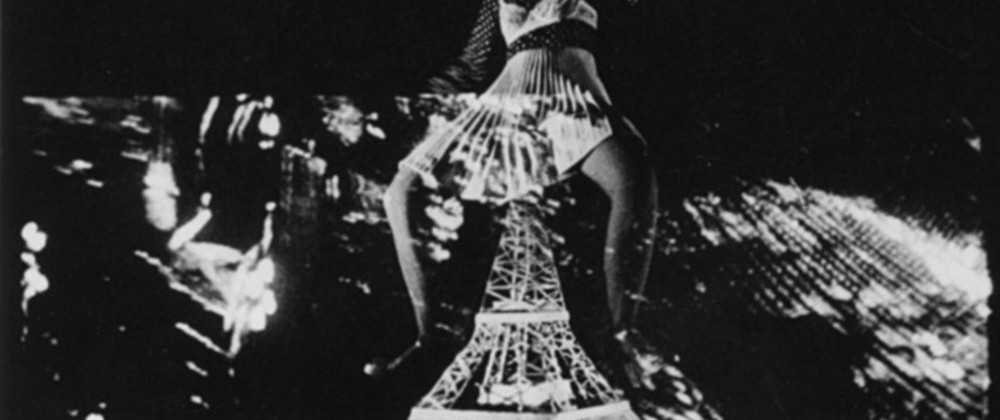
In this second part of the DVD review essay I will turn my attention to three filmmakers considerably younger than Valie Export and (especially) Kurt Kren, Mara Mattuschka (born 1959 in Bulgaria but trained in Vienna), Gustav Deutsch (born in 1952), and Manfred Neuwirth (born in 1954). Since Kurt Kren’s Actionist films of the 1960s (represented on the Index DVD 001) the human body has become an integral theme/subject in Austrian experimental cinema, none more so than in the works of Valie Export, dealt with in part one of this essay, and Mara Mattuschka, who “like her [alter ego] heroine Mini Minus, transformed exhibitionism into an art.” [1] Nineteen years her junior, Mattuschka continues Export’s concern with feminized body politics but with a less confrontational tone and a more comic approach.
Mara Mattuschka
The Mara Mattuschka DVD gets off to a strong start with NabelFabel (Navel Fable, 1984, 16mm, 3 min.), by far the darkest film on the DVD. In fact this short is a good deal more terrifying than most horror films, with its striking images of confinement, claustrophobia, and social oppression. The film begins with a mannequin’s face wrapped up in newspaper which is unravelled in pixilated fashion. The nondescript face is replaced by a human face (Mattuschka’s I presume) wrapped in a stocking. Layers are continually removed only to helplessly reveal another stocking below. Adding to the tension and sense of oppression is the pained expression of the face (also animated) and a soundtrack comprised of a heartbeat, the sound of material being torn, primal screams, photographic shutter clicks, and electronic music. Although the liner notes interpret the film as a symbolic second birth, the foreboding atmosphere can also suggest a person trying to escape from a painful cocoon of imprisonment.
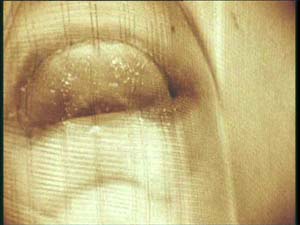
Of the 12 films presented on the Mattuschka DVD several recall the work of Valie Export, including two which deal directly with female sexuality. The more substantial of the two is Der Untergang der Titania (The Sinking of Titania, 1985, 16mm, 4 min.), a comic, scatological love story played out in a bathtub, narrated by an 18 year old woman recounting her perverse sexual awakening. The short film uses a mixture of live action with primitive stick men animation, but conflates the two forms by filming Mattuschka’s alter ego Mimi Minus, bath cap and all, as if she were an animated cut-out figure. The film’s style is of one piece, with even jerky left-right camera pans mimicking the animated movements of the Mimi Minus character. The tub drain becomes a surrogate anus, first ejecting an animated stick man sporting an erect penis –after which Mattuschka cuts in a subliminal close-up of a hand holding a phallic cigarette– and then ejecting animated feces.
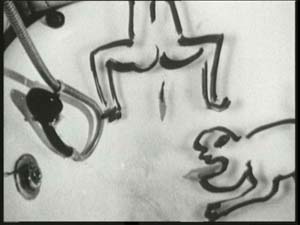
The stick man eventually defecates on Mimi, darkening the tub water and sinking Titania (the character’s name) figuratively deeper into her unconscious. The film is very reminiscent of Export’s own groundbreaking masturbation tub film Mann & Frau & Animal (which is not without its own humor). Of lesser value is Danke, es hat mich sehr gefreut (I Have Been Very Pleased, 1987, 16mm, 2 min.), a silly one joke film where Mimi Minus masturbates in a sea of overexposed white made to appear like a beach (she wears sunglasses). Her orgasm is a reverberating, child-like laughter which gives way to a moan and a concluding line of dialogue which forms the film’s title: “Thank you. I have been very pleased.”
Kugelkopf (Ball-Head , 1985, 16mm, 6 min.) is at times similar to NabelFabel, with images of a bandaged face, again Mattuschka as Mimi Minus. The film begins with Mimi in front of a mirror shaving her head. The moment is perhaps a reference to post-World War 2 France, when thousands of women, called “femmes tondues” or “shorn women,” were punished for being Nazi sympathizers by having their head shaved so they could be identified as such in public. The shaving is captured in extreme close-up, and includes another subliminal flash frame of a straight razor superimposed over a shut eye –an homage of course to Un Chien Andalou.
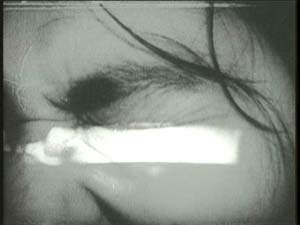
The shaving leads to head cuts which cause animated blood to ooze from Mimi Minus’ head onto her face, covering her head like paint. The film continues with a slow motion montage of her face being bandaged, which echoes the opening newspaper bandaged head in NabelFabel. The short concludes with another montage, this time of extreme close-up views of Mattuschka’s face literally being ‘painted’ in blood. This theme of painting on the body introduced in Kugelkopf with the animated blood covering the head and face is continued in later Mattuschka films.
Using the body –in this case the hand– as a painting tool informs much of Pascal-Gödel (1986, 16mm, 5 min.), a formal study in contrast, with black and white, the use of a checkerboard, and positive/negative imagery. The sparse black and white sets recall a film featuring another ‘tortured’ woman, Carl Dreyer’s The Passion of Joan of Arc (1928). In Parasympathica (1986, 16mm, 3 min.) there is a continuation of the study in polarity and the black and white motif, with Mattuschka splitting her body in half vertically with her left side painted in black and her right side painted in white.
Der Schöne, die Biest (Beauty and the Beast, 1993, 16mm, 10 min.) finds Mattuschka in pure comic mode, as a chameleon playing many roles to her baby child: mother (we see her breast feeding in close-up), entertainer/teacher (playing violin to her baby); protector (adopting the role of a samurai by using a kitchen knife as if it were a sword) and prognosticator (a fortune teller seeing into her baby’s future). Der Schöne, die Biest is evidence of Mattuschka’s continuing exploration of the concept of ‘expanded cinema’ developed by Valie Export and others in the 1960s. An ‘expanded cinema’ trait visible in this and other Mattuschka films, and no doubt influenced by the Austrian Actionist films, is the heightened performative aspect of Mattuschka’s acting (as performed by her alter ego Mimi Minus).
This performative aspect is in evidence in the two final films, which are also among the best on the DVD collection, S.O.S. Extraterrestria (1993, 16mm, 10 min.) and ID (2003, Betacam, 10 min.). As noted in my comments on some of the earlier films, Mattuschka is well aware of cinema history and not averse to intertextual references to past films. S.O.S. Extraterrestria is by far the most intertextual film in the collection, with a multi-perspective referencing of the classic monster movie. Employing some fairly elaborate miniature and special effects cinematography, Mimi/Mattuschka appears as a giant woman causing city-wide havoc. The most obvious film reference is to King Kong, with the female replacing the ape as outsider/outcast/oppressed/exploited, but some of the set pieces and actions reference Godzilla, the pseudo-feminist The Attack of the 50 Foot Woman, and Federico Fellini’s contribution to the 1962 omnibus film Boccaccio ‘70, “The Temptation of Antonio.” The theme of masturbation also returns in perfect accord with the film’s intertextuality: the oversized Mimi ‘mounts’ the Eiffel Tower and masturbates on it (as revision of King Kong scaling the Empire State Building). Along with some iconic big monster shots, like the shot of her huge face looking into an apartment window (from King Kong), Mimi’s “grotesque body-art-performances” [2] begins with her in the make-up room putting on a bizarre costume which includes a ludicrous wig, and concludes with her performing all the famous big movie monster gestures: hovering over light towers, trains, and clock towers, swatting at planes, stomping on people, picking people up and eating them, scaling tall buildings, etc.
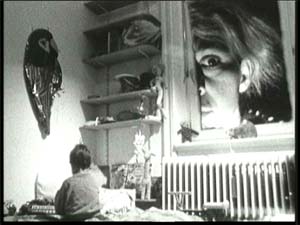
The final film of the DVD, ID, is also the only non-16mm film on the DVD, and the first she shot on video (Betacam). The film, complex, poetic, and surreal, works well as the last film on the collection. The film begins with Mattuschka, sporting a black wig, riding up an escalator which leads to a void which she falls into, in effect entering her own psyche, where she turns into a bizarre looking monster, part John Merrick, part lizard. The creature eventually splits into two, manifesting her döppelganger. The monstrous Mattuschka and her double dance in bizarre ritualistic movements that give way to violence and cannibalism (one rips out the other’s umbilical cord and bites it). This film cements another theme prevalent across her work, that of ‘masks’ that conceal one’s true identity, like the pseudonym Mimi Minus, but also through many physical masks (wigs, the stocking tights, the makeup in Beauty and the Beast, the mask in Ball Head, the crown in Parasympathica, and the monster döppelganger in ID). When her transformation begins Mattuschka is floating in a milky cloud, an image which gives the impression of a rebirth –another recurring theme. From this overexposed, white backdrop the film cuts to Mattuschka emerging out of a black marsh, with a backdrop of long straw-like black hair; she struggles with her döppelganger and then returns back to the reality of the escalator. The film is a perfect closer because it brings together the many themes seen across the earlier works: rebirth, the body, masks, the double, and the outsider; in short, the morbid with a touch of comedy.

Gustav Deutsch
The films on the Gustav Deutsch DVD are part of an ongoing “work in progress” project entitled Film ist. (1-12)_(_Film Is. (1-12) which began in 1996. The project is unique in that it is part archival document, part theory and part history. Using the found footage format Deutsch uses mainly early cinema extracts, along with ephemeral cinema (science films, educational films, etc.) to recount a visual-audio poem to both film history and an open-ended philosophical query into the ontology of film. Because of its found footage nature the project has much in common with Al Razutis’ earlier projects Amerika and Visual Essays: Origins of Film the more recent works of Bill Morrison, Richard Kerr (collage d’hollywood, 2003) and his compatriot Peter Tscherkassky.
The project is broken down into two halves, Film ist. (1-6)_(_Film is. (1-6) and Film 1st. (7-12), totalling 77 minutes. Each of the twelve sections is given a sub-title which closely describes the section’s content. What follows is a section by section breakdown with brief commentary:
1. Movement and Time. This section brings us back to the origins of film, and the pre-cinema scientific experiments in movement pioneered by Eadweard Muybridge and Étienne-Jules Marey. A wider variety of subjects are seen in movement: cats, birds, a baby, an athlete throwing a discus, a pheasant, an ape, all moving in slow-motion, some made to move in opposite directions, at times in reverse, some flying, some walking easily, others with difficulty. Sound helps bring them beyond what they are –scientific films– to poetic interchanges.
2. Light and Darkness. From ‘movement and time’ (which echoes Gilles Deleuze’s two books on cinema, The Movement-Image and The Time-Image) Deutsch moves onward to the next primary elements of cinema, light and darkness. The section begins with a close-up of an eye, then of a dilating pupil, which sets up the motif of looking and the properties of light and darkness fundamental to cinema. Throughout the section we hear nocturnal sounds that keep the audio figuratively ‘in the dark,’ while the image fluctuates between dichotomies of light/dark: storms, lightning, universe and the stars, etc.
3. An Instrument. This section turns the attention over to sound, featuring a science film of musicians being tested on a type of audio machine. What would a found footage film be without footage of crash test dummies, laid out over the voice of an opera singer?
4. Material. This is the section which most recalls the films of Bill Morrison, and the cinema of ruins. Deutsch presents a series of freeze frames of films in varying states of deterioration. Frames are moved into view vertically, as they do when moving through the projector gate; hence the ‘material’ is both the film stock and the projector apparatus. The section ends with a flurry of white dots superimposed over a negative image of a woman seated in a train. As the dots increase so too does the rhythm of the sound, a syncopated beeping which sounds like a projector sound head.
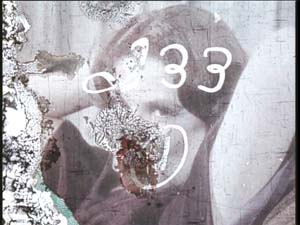
5. A Blink of an Eye. This section moves us from the material properties of cinema, to the perceptual properties of the mind’s eye, the necessary addition which concludes the illusion of movement. The title alludes to the myth of persistence of vision, long debunked as the single explanation for how we see movement in the movies. The found footage shows people having their eyes tested. One woman with a patch on one eye watches a spinning circle. Another woman is hooked up to a machine monitoring her brain patterns. These laboratory shots are intercut with a large snake attacking a rodent. The split second ‘blink of an eye’ attack is slowed down to microscopic detail.
6. A Mirror. We now move to film as a reflection of reality. The montage begins with a fascinating Kuleshovian experiment. One found footage sequence is a series of shots showing a variety of couples seated side by side. In all of the shots the two people bear a strong resemblance, in effect ‘mirroring’ each other, and are looking off screen at something which appears painful to watch. These are then intercut with an explicitly graphic close-up of an eye being operated, which gives a partly comical, partly reflective meaning to the reactions shots of the couples.
Film Ist. (7-12)
7. Comic. The second part continues the “Kuleshovian” experiment of the previous section, with point of view shots ill-matched for comic effect. A person looks into a basement window and the shot cuts to a shot of a sailboat at sea, etc.
8. Magic. This section is essentially an homage to Georges Méliès and early fantasy cinema, with extracts from Méliès’ films alternated with extracts from Fritz Lang’s Siegfried Tod. Cinema is presented as a fever dream, with a smorgasbord of primitive special effects (superimpositions, stop-motion substitutions, hand tinted colors, shooting in reverse, etc.). There is great use of contemporary electronic music and sound effects to make old images appear new and fresh.
9. Conquest. This section moves from the concerns of form and subject matter to politics. Much of early cinema gave visual expression to the expanding world made possible through the new technologies of transport, travel, and communication. The Lumière brothers “cinematograph” was the first but certainly not last “filmic flaneur,” giving Americans and Europeans their first glimpse of the exotic and the far away. Looked at today much of these film travelogues reflect the ideology of colonialism, depicted throughout this section and set up with the first striking juxtaposition from a drawing room full of bourgeois people, to a close-up of a single African American Native staring back at the camera. This contrast between white/black, culture/nature, first world/third world, artificial set/on-location natural set is present in the whole section, implicating, by extension, the whole capitalist infrastructure of commercial cinema. Deutsch’s montage includes suggestive graphic matches from a bourgeois woman in mid-frame turning her head, to a Native woman framed likewise making a similar turn, or a white hunter opening the huge mouth of a felled hippopotamus, to a white man opening the mouth of a native.

10. Writing and Language. Self-explanatory. A montage of silent film intertitle cards and text within film (i.e. someone holding up a board with writing on it, etc.).
11. Emotions and Passion. This section turns its attention to silent film melodrama, where “emotions” are the exclusive domain of the woman. Hence the copious close-ups of screen divas and the more identifiable clichés of emotional expression.
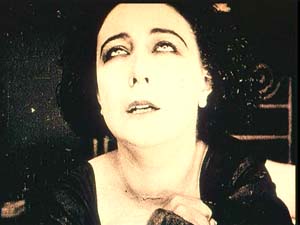
12. Memory and Document. The project comes to its temporary conclusion with another Kuleshov effect achieved by repeatedly cutting from a shot of a photographer behind his camera preparing to take a photograph, and people posed in wait for a portrait. Deutsch positions us like the people poised for the photographer, waiting, as the final title card reads, for the film “to be continued.”
Manfred Neuwirth
The Manfred Neuwirth DVD provides an interesting change of pace from the other four filmmakers looked at across this two-part essay. Unlike the other DVDs this one feels complete, in the sense that it represents a completed trilogy, the [ma] Trilogy. [3] Neuwirth’s trilogy consists of Tibetische erinnerungen_(_Tibetan Recollections (1988-1995, 22: 26), Manga Train (1998, 20:45), and Magic Hour (1999, 45 min.). The trilogy is a strange beast that is hard to categorize, and can best be likened to the classic city films of the 1920’s and 1930’s: Rien que les heures (1926), Berlin Symphony of a Great City (1927), Man With a Movie Camera (1929), Rain (1929) and A Propos de Nice (1930). Although a direct outgrowth of the modernist movement of the teens and twenties, the city film has had a rebirth with such films as Koyaanisqatsi (1983), Powaqqatsi (1988), and Naqoyqatsi, (2002), Baraka (1992), Elsewhere (2001), and Gambling, Gods, and LSD (2003). Like many of the city films old and new, Neuwirth’s trilogy is part documentary, part ethnography, and part experimental.
The influence of Kren is also evident in Neuwirth’s trilogy, in the way the films abide by a rigorous, ‘systemic structure.’ All three films are composed of shots of equal length, 40 seconds in Manga Train and Magic Hour and 35 seconds in Tibetan Recollections, and are slowed down to exactly one-fifth their regular speed. The result is a regulated, tranquil rhythm with each shot a self-contained unit. The three films are film diaries taken in, respectively, Tibet, Japan, and Austria. Unlike most ‘city films’ which have a structure usually based on a chronological or categorical order, Neuwirth’s films are much more free-form and intuitive, with little if any rational connection between shots or from beginning to end. Neuwirth refers to himself as a ‘filmic flaneur,’ which captures his philosophical approach as a film-diary traveller, but with more of an ethnographic bent because he stays in the places he shoots in for long periods of time. This is especially the case with the first film in the trilogy, Tibetische Erinnerungen_(_Tibetan Recollections, shot between 1988 and 1995. This film contains one of the few shots in the trilogy not taken by Neuwirth, a video shot of a Tibetan man being brusquely arrested by Chinese military officials, which sets a political tone for some of the subsequent imagery. Like an old-school ethnographer, Neuwirth rarely intrudes with the subject. Images alternate between empty frames, people doing chores, and a recurring motif of human bodies that are fragmented by the frame (a formal pattern across the trilogy). Every sequence shot is punctuated by a fade in/out. Since every shot is the same length, one soon falls into the leisurely rhythm (augmented by the slow motion) and knows how much time they have to peruse each new ‘photograph.’ Both Tibetan Recollections and Manga Train end fittingly with shots suggesting a traveller about to move on to another place. Tibetan Recollections ends with a point of view shot taken from a car looking out onto the dirt road ahead as the vehicle drives on; while Manga Train concludes with a point of view shot from a moving vehicle looking at a distant train moving screen left to right.
Whereas Tibetan Recollections was shot in 1.33 full frame, Manga Train and Magic Hour were shot in 16.9 widescreen. Manga Train begins with a shot of two people reading a newspaper on a train, perhaps the source for the film’s title. Although the notion of the traveller is present in all three films, Manga Train features a higher percentage of shots of ‘transit’ spaces, like trains, subways, airports, highways, etc. Since each image in the trilogy is self-contained and not linked in any rational way to the previous, they can be labelled Deleuzian ‘time-image’ shots, sets of action in which the rational sensor motor connection between shots is unstated and it is left up to the viewer to supply the meaning.
The sound design is another important element in the trilogy. Although every shot in the trilogy is slowed down, the sound is not as rigid in this sense. At times the sound appears natural, as with dialogue, while at other moments the sound assumes the slowed down speed of the image. It is also sometimes difficult to ‘place’ the sound in relation to the images. The sounds are not always synchronous, yet when they are not they still place you in the space of the image. Other times the sound is synchronous, yet seems distanced and alienated from the image. One subject that Neuwirth seems fond of is nature, and more precisely, the recording of nature’s sounds: rain, thunder, and wind. Another motif which runs across the trilogy is the notion of watching, which seems appropriate given Neuwirth’s reference of himself as a ‘filmic flaneur.’ There is one shot in Magic Hour, a close-up of a hand manipulating the dial on a short wave radio in search of a clear signal, which fuses sound –with the man in the shot being a ‘sonic flaneur’– to this notion the ‘filmic flaneur.’
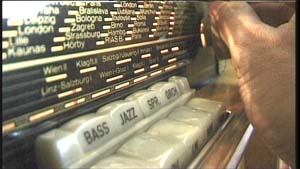
The act of watching is also sometimes subtly inscribed in the film’s composition, with frame-within-frame set-ups that imply a surrogate viewer.

Although there are subtle differences across the three films –like for example the fact that Magic Hour begins with nondescript images which do not immediately identify where the images are from– this is as homogenous and satisfying a trilogy as you will find.
Taken as a whole these films and videos are connected by an overall desire (or need?) to puncture through conventional means of self-expression. The range of emotions run the gamut, from pure sensorial impression, to anti-bourgeois agit-prop, to outright Dadaist shock. The films of Kren and Export are clearly informed by the political movements and theoretical programs of the 1960’s and 1970s, including feminism, semiotics, structuralism, Actionism, Marxism, and the body politics that grew out of the sexual liberation; while the works of the younger filmmakers Deutsch, Mattuschka, Neuwirth, while no doubt inspired by Kren and Export, introduce a more playful sense of reflexivity to their self-expression. All in all the Index program is a remarkable achievement in cinematic archiving. The DVDs themselves come in clear shells, with an attractive, minimalist cover design that is the same for every DVD in the collection. The DVDs also come with extensive bilingual (German & English) liner notes that include filmographic detail and helpful critical annotation for each film. Especially welcome is the long piece by Tom Gunning on the Deutsch DVD, “Film ist. A Primer for a Visual World.” There is no doubt –as Peter Rist has said in his piece on Peter Tsscherkasky– that certain of these films are meant to be seen on the big screen for their full sensorial experience. But watching them on a large screen TV, or a smaller computer screen is another experience with its own private rewards. Being able to see them in any context is a sign of just how far we have come along in the digital revolution; and a sign of just how prescient the term “expanded cinema” was.
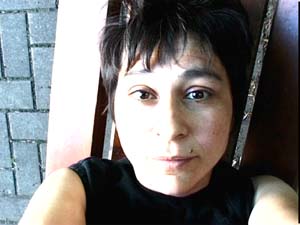
To purchase any of these DVDs please visit the Index website.
Endnotes
1 L’Avant-garde autrichienne au cinema 1955-1993. Centre Georges Pompidou: Paris, 1996. Catalogue Direction, Jean-Michel Bouhours, p. 26 (my translation).
2 Stefan Grissemann, liner noted of the DVD, p. 15.
3 Well, not quite complete. Since the release of the DVD Neuwirth has returned to Tibet and made a follow-up film in 2005, Tibet Revisited. For info on the follow-up film you can go to Neuwirth’s website.
Bibliography
Export, Valie. “Expanded Cinema as Expanded Reality.” Senses of Cinema. Issue 28 (Sept.-Oct., 2003). Accessed 18 Dec. 2005.
L’Avant-garde autrichienne au cinema 1955-1993. Centere Georges Pompidou: Paris, 1996. Catalogue Direction, Jean-Michel Bouhours.
Morris, Garry. “Sorry! It Had to Be Done! Radical Actioner Kurt Kren.” Bright Lights Film Journal. Issue 24 (April 1999). Accessed Dec. 15, 2005.
Neuwirth, Manfred. Personal Website. Accessed Dec. 15, 2005.
“Peter Tscherkassky & the Austrian Avant-Garde.” Sense of Cinema. Issue No. 28 (Sept.-Oct. 2003). Accessed Dec. 15, 2005.
Tscherkassky, Peter. “Lord of the Frames: Kurt Kren.” Accessed Dec. 12, 2005.
Youngblood, Gene. Expanded Cinema (now available in part or whole as an online book)



